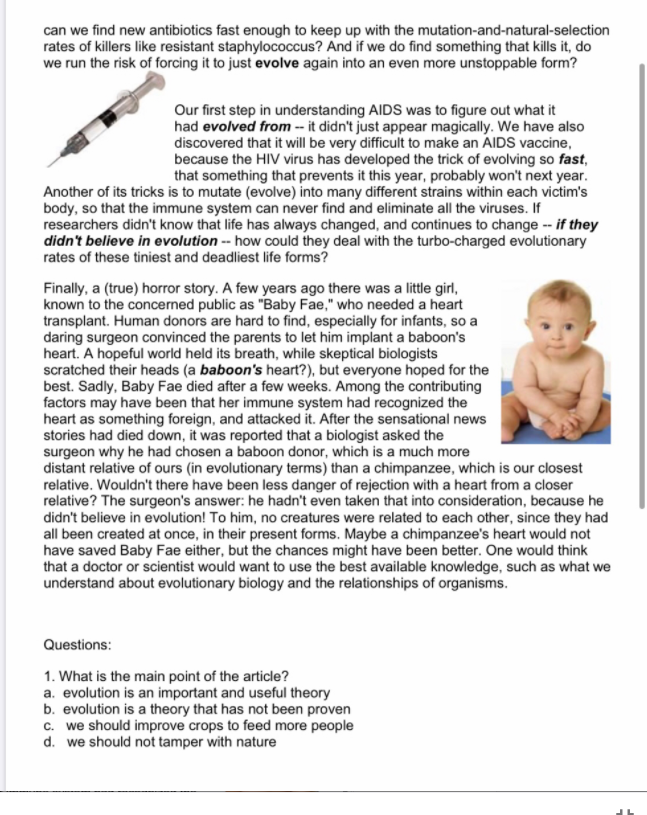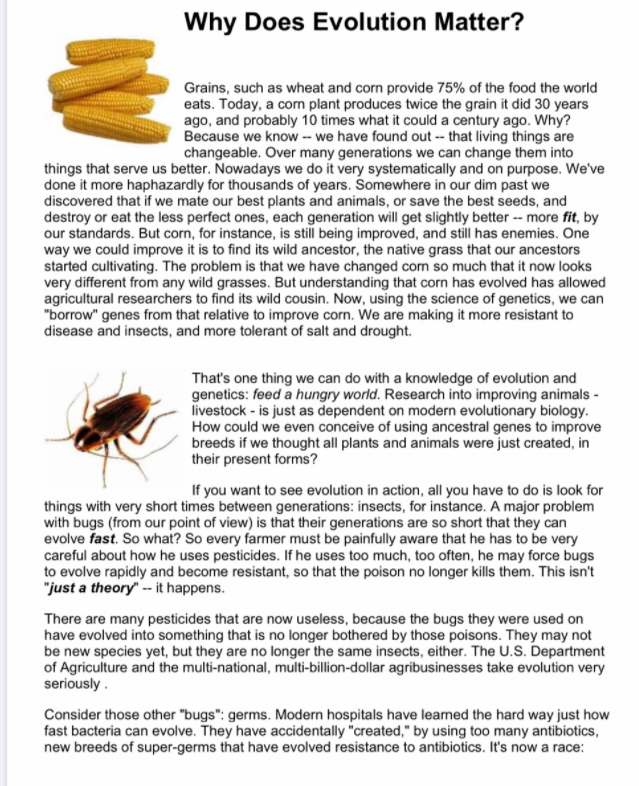3Why did the doctor NOT choose a chimpanzee heart to donate to Baby Fae? Do you think the baby’s chances would have been better if he had? 4. What do you think is the main message the author wanted to get across with this article?
3Why did the doctor NOT choose a chimpanzee heart to donate to Baby Fae? Do you think the baby’s chances would have been better if he had? 4. What do you think is the main message the author wanted to get across with this article?
Human Anatomy & Physiology (11th Edition)
11th Edition
ISBN:9780134580999
Author:Elaine N. Marieb, Katja N. Hoehn
Publisher:Elaine N. Marieb, Katja N. Hoehn
Chapter1: The Human Body: An Orientation
Section: Chapter Questions
Problem 1RQ: The correct sequence of levels forming the structural hierarchy is A. (a) organ, organ system,...
Related questions
Question
3Why did the doctor NOT choose a chimpanzee heart to donate to Baby Fae? Do you
think the baby’s chances would have been better if he had?
4. What do you think is the main message the author wanted to get across with this
article?

Transcribed Image Text:can we find new antibiotics fast enough to keep up with the mutation-and-natural-selection
rates of killers like resistant staphylococcus? And if we do find something that kills it, do
we run the risk of forcing it to just evolve again into an even more unstoppable form?
Our first step in understanding AIDS was to figure out what it
had evolved from -- it didn't just appear magically. We have also
discovered that it will be very difficult to make an AIDS vaccine,
because the HIV virus has developed the trick of evolving so fast,
that something that prevents it this year, probably won't next year.
Another of its tricks is to mutate (evolve) into many different strains within each victim's
body, so that the immune system can never find and eliminate all the viruses. If
researchers didn't know that life has always changed, and continues to change -- if they
didn't believe in evolution -- how could they deal with the turbo-charged evolutionary
rates of these tiniest and deadliest life forms?
Finally, a (true) horror story. A few years ago there was a little girl,
known to the concerned public as "Baby Fae," who needed a heart
transplant. Human donors are hard to find, especially for infants, so a
daring surgeon convinced the parents to let him implant a baboon's
heart. A hopeful world held its breath, while skeptical biologists
scratched their heads (a baboon's heart?), but everyone hoped for the
best. Sadly, Baby Fae died after a few weeks. Among the contributing
factors may have been that her immune system had recognized the
heart as something foreign, and attacked it. After the sensational news
stories had died down, it was reported that a biologist asked the
surgeon why he had chosen a baboon donor, which is a much more
distant relative of ours (in evolutionary terms) than a chimpanzee, which is our closest
relative. Wouldn't there have been less danger of rejection with a heart from a closer
relative? The surgeon's answer: he hadn't even taken that into consideration, because he
didn't believe in evolution! To him, no creatures were related to each other, since they had
all been created at once, in their present forms. Maybe a chimpanzee's heart would not
have saved Baby Fae either, but the chances might have been better. One would think
that a doctor or scientist would want to use the best available knowledge, such as what we
understand about evolutionary biology and the relationships of organisms.
Questions:
1. What is the main point of the article?
a. evolution is an important and useful theory
b. evolution is a theory that has not been proven
c. we should improve crops to feed more people
d. we should not tamper with nature

Transcribed Image Text:Why Does Evolution Matter?
Grains, such as wheat and corn provide 75% of the food the world
eats. Today, a corn plant produces twice the grain it did 30 years
ago, and probably 10 times what it could a century ago. Why?
Because we know -- we have found out -- that living things are
changeable. Over many generations we can change them into
things that serve us better. Nowadays we do it very systematically and on purpose. We've
done it more haphazardly for thousands of years. Somewhere in our dim past we
discovered that if we mate our best plants and animals, or save the best seeds, and
destroy or eat the less perfect ones, each generation will get slightly better -- more fit, by
our standards. But corn, for instance, is still being improved, and still has enemies. One
way we could improve it is to find its wild ancestor, the native grass that our ancestors
started cultivating. The problem is that we have changed con so much that it now looks
very different from any wild grasses. But understanding that corn has evolved has allowed
agricultural researchers to find its wild cousin. Now, using the science of genetics, we can
"borrow" genes from that relative to improve corn. We are making it more resistant to
disease and insects, and more tolerant of salt and drought.
That's one thing we can do with a knowledge of evolution and
genetics: feed a hungry world. Research into improving animals -
livestock - is just as dependent on modern evolutionary biology.
How could we even conceive of using ancestral genes to improve
breeds if we thought all plants and animals were just created, in
their present forms?
If you want to see evolution in action, all you have to do is look for
things with very short times between generations: insects, for instance. A major problem
with bugs (from our point of view) is that their generations are so short that they can
evolve fast. So what? So every farmer must be painfully aware that he has to be very
careful about how he uses pesticides. If he uses too much, too often, he may force bugs
to evolve rapidly and become resistant, so that the poison no longer kills them. This isn't
"just a theory" -- it happens.
There are many pesticides that are now useless, because the bugs they were used on
have evolved into something that is no longer bothered by those poisons. They may not
be new species yet, but they are no longer the same insects, either. The U.S. Department
of Agriculture and the multi-national, multi-billion-dollar agribusinesses take evolution very
seriously.
Consider those other "bugs": germs. Modern hospitals have learned the hard way just how
fast bacteria can evolve. They have accidentally "created," by using too many antibiotics,
new breeds of super-germs that have evolved resistance to antibiotics. It's now a race:
Expert Solution
This question has been solved!
Explore an expertly crafted, step-by-step solution for a thorough understanding of key concepts.
This is a popular solution!
Trending now
This is a popular solution!
Step by step
Solved in 2 steps

Knowledge Booster
Learn more about
Need a deep-dive on the concept behind this application? Look no further. Learn more about this topic, biology and related others by exploring similar questions and additional content below.Recommended textbooks for you

Human Anatomy & Physiology (11th Edition)
Biology
ISBN:
9780134580999
Author:
Elaine N. Marieb, Katja N. Hoehn
Publisher:
PEARSON

Biology 2e
Biology
ISBN:
9781947172517
Author:
Matthew Douglas, Jung Choi, Mary Ann Clark
Publisher:
OpenStax

Anatomy & Physiology
Biology
ISBN:
9781259398629
Author:
McKinley, Michael P., O'loughlin, Valerie Dean, Bidle, Theresa Stouter
Publisher:
Mcgraw Hill Education,

Human Anatomy & Physiology (11th Edition)
Biology
ISBN:
9780134580999
Author:
Elaine N. Marieb, Katja N. Hoehn
Publisher:
PEARSON

Biology 2e
Biology
ISBN:
9781947172517
Author:
Matthew Douglas, Jung Choi, Mary Ann Clark
Publisher:
OpenStax

Anatomy & Physiology
Biology
ISBN:
9781259398629
Author:
McKinley, Michael P., O'loughlin, Valerie Dean, Bidle, Theresa Stouter
Publisher:
Mcgraw Hill Education,

Molecular Biology of the Cell (Sixth Edition)
Biology
ISBN:
9780815344322
Author:
Bruce Alberts, Alexander D. Johnson, Julian Lewis, David Morgan, Martin Raff, Keith Roberts, Peter Walter
Publisher:
W. W. Norton & Company

Laboratory Manual For Human Anatomy & Physiology
Biology
ISBN:
9781260159363
Author:
Martin, Terry R., Prentice-craver, Cynthia
Publisher:
McGraw-Hill Publishing Co.

Inquiry Into Life (16th Edition)
Biology
ISBN:
9781260231700
Author:
Sylvia S. Mader, Michael Windelspecht
Publisher:
McGraw Hill Education